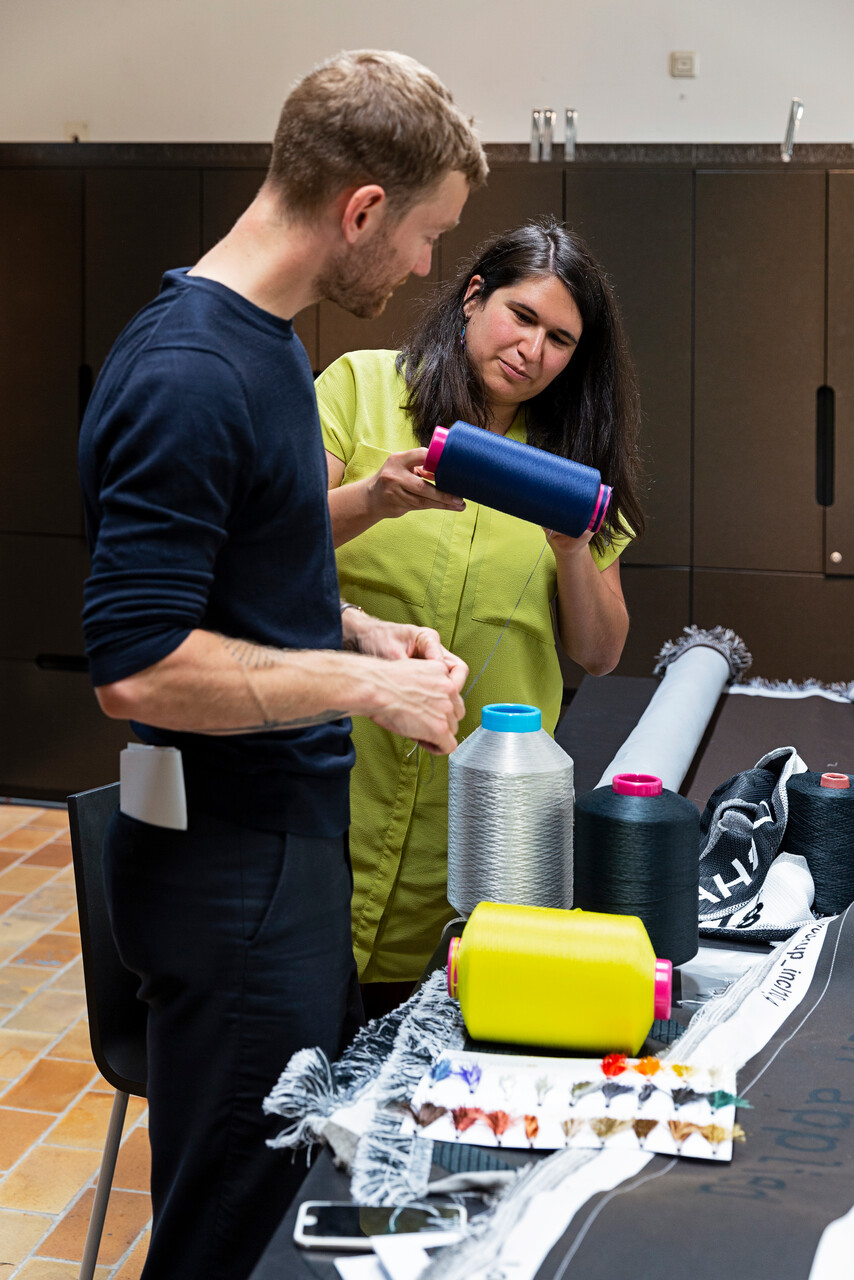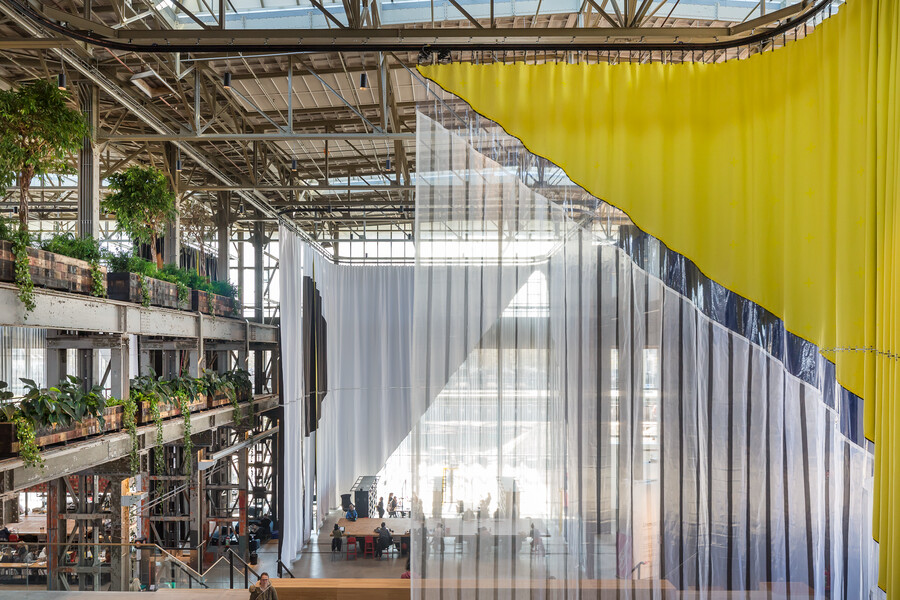Textile works developed for public spaces generally have to meet specific fire-safety requirements. To ensure we provide makers and their clients with relevant advice, the TextielLab researched all the fire-retardant options. In this article, we provide an overview of the choices you will face.
As soon as a client commissions you for a textile project in a public building, these are the questions you should be asking: does the work have to be fireproof, what standards does it have to comply with, and does the client want an official certificate? Fireproof does not necessarily mean that a fabric is non-flammable, but that it does not fuel the fire or spread it quickly. The term used for textiles is ‘fire retardant’, or FR for short. For example, FR tests assess how easily a fabric catches fire, whether it releases dangerous fumes and how quickly it chars and burns out.
Various fire-safety standards and certificates exist. These influence the material you can use: the stricter the standard, the more limited the choice. Don’t forget that testing and certification cost time and money. Clients sometimes request a certificate for convenience’s sake, without realising that this reduces the maker’s creative options or that it can add up to 7,500 euros to the price and six months to the production time. Figuring out what is absolutely necessary is a tricky technical task but worth the effort. To protect makers and their clients from unnecessary restrictions, costs and delays, the TextielLab researched all the options in 2021. Based on the results of the research, the product developers can provide fire-safety advice, although the ultimate decision lies with the client. As this is a rather technical subject, we outline the options and consequences below.

Photo Josefina Eikenaar
Free-standing work or integral interior design?
The first step is to determine whether a work needs to be fire retardant at all. Does the work pose a fire hazard in the public space? The answer to this question depends very much on the circumstances. Smaller, free-standing works often do not need to be fire retardant. For example, Sigrid Calon’s 30 woven flags for Tilburg University or Koen Taselaar’s tapestry for De Vrijstaat in Utrecht did not have to be made with fire-retardant yarns or a special coating. However, this is mandatory for applied interior designs that form an integral part of the space, such as larger wallcoverings, upholstery, curtains and textile room dividers. The wallcovering for the restaurant in Paleis ‘t Loo and the lobby of the Royal Theater Carré in Amsterdam as well as the curtains for the LocHal building in Tilburg are examples of projects where fire safety was an important requirement.
Coating or impregnating
Coating or impregnating textiles is not something that the product developers in the TextielLab are quick to recommend. The advantage of this option is that you can use any yarn you want, but it also has quite a few disadvantages. The treatments create a slightly sticky layer that may also cause discolouration or shrinkage or weigh down the fabric. In addition, the chemical protection disappears as soon as the substance is exposed to water. Even if it stays dry, the treatment has to be repeated every five years – and even then meeting the required standard during testing is not guaranteed. You might still choose this option, for example because the textile has already been developed or because you specifically want to work with wool or linen. We recommend that you test the coating or impregnation on your samples during the development process to see how it affects the fabric. Specialist impregnation companies, such as Brand Prevent, apply these treatments. The official testing and certification are done by another company, the costs of which can be as high as 7,500 euros per fabric.

Inside Outside’s fireproof curtains in the LocHal. Photo Peter Tijhuis
Working with FR yarns
Fire-retardant or FR yarns are (semi-)synthetic yarns that have had a flame retardant added to the fibre during the production process. The benefit of using these yarns is that the fabric itself does not need to be treated. The range of available FR yarns is limited when it comes to structure and shine. Nevertheless, you should be able to find something to suit your needs, from bouclé or smooth to a cotton-look yarn. We work with several FR yarns in the lab, so you are not restricted to Trevira CS, the best-known brand for FR yarns. The standard black-and-white warp on the looms in the TextielLab still uses Trevira CS, but we are looking for a recycled option that will enable us to develop fire-retardant projects more sustainably. We also want to increase the overall selection of recycled FR yarns this year.
Testing and certification
Standards differ from country to country and are also regularly updated. Make sure you know which standard your work has to comply with and confirm whether you need a certificate. Once you know what the requirements are, put them on paper, so that it is clear which standard you are following. In the Netherlands, Efectis in Bleiswijk and the Textile Lab in Hengelo carry out fire-safety testing and certification. If you need a certificate, we advise sending interim samples to one of these companies before you buy the yarns for the final fabric. If the samples pass the test, we will produce extra fabric from your final work that can be tested again for certification.
Testing and certification are not cheap. You should budget around 7,500 euros per work. You can also submit fabric for testing without certification, which will immediately reduce the costs by a few thousand euros. You are responsible for discussing and negotiating the costs with the impregnation and testing companies directly.

Bas van Beek and Lotte van Dijk working on the fire-retardant wallcovering for Carré. Photos Patty van den Elshout
Wallcovering for Carré
During the renovation of the Loge Foyer on the first floor of Amsterdam’s Royal Theater Carré, several layers of wallpaper were found behind old panels dating from the time when this was the Carré family’s living room. The theatre commissioned artist Bas van Beek to design a new wallcovering inspired by the historical wallpaper patterns. He developed the work with product developer Lotte van Dijk. To ensure fire-safety compliance, the client initially suggested impregnating the fabric, but the lab team advised using cotton-look FR yarns. On the loom, this presented the challenge of incorporating the fine lines and intricate details of the design into the compact jacquard weave, which is composed of dozens of threads per centimetre. The use of two yarns solely for the back of the fabric reduced the number of changes per centimetre and kept the loom running smoothly. By testing the interim and final samples, Carré was able to achieve the required certification.